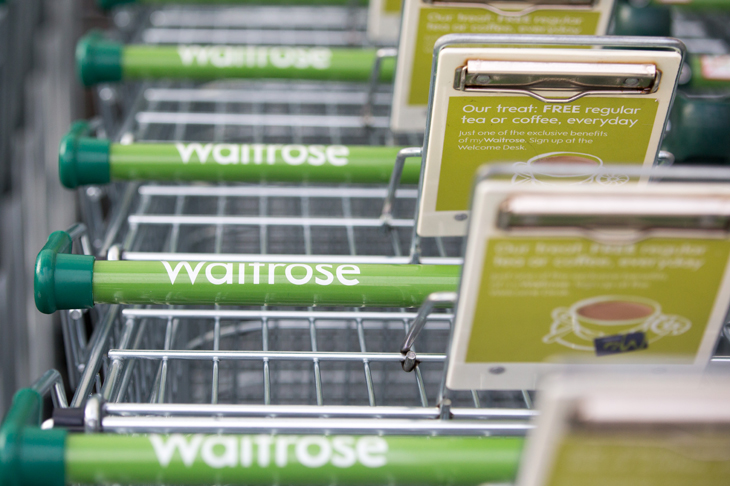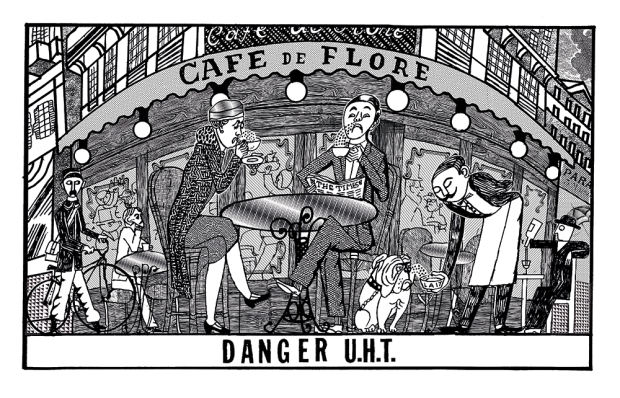A few years ago, some friends came to stay with us on Exmoor. After they unfurled from their Volvo, they presented us with some unctuous Parma ham and a few bottles of Barolo, all of which I received eagerly. ‘Thank you so much!’ I cried, adding, ‘Such a shame we don’t have any Charentais melons, otherwise we could have this as a starter tonight!’
Even though he’d just ferried his family four hours from Primrose Hill and up our bone-shaking unmade track to reach the valley, Justin looked stricken at the thought of Parma ham sans melon. ‘No problem, I’ll run and get some,’ he said, jumping back into the driver’s seat. Then he poked his head out of the window. ‘Where’s your nearest Waitrose?’ he asked, as if there would be one in the village.
I still don’t know where the nearest Waitrose is (Bristol? Barnstaple?) But the point is this: for the middle-class foodie shopper (i.e. cooks from scratch, doesn’t flinch at complicated Ottolenghi recipes demanding dozens of ‘foreign’ ingredients called things like zaatar and freekeh), Waitrose, which has a 5 per cent market share in the UK, has always been the numero uno assoluto supermarket in the country.
It was also the ultimate middle-class signifier. When a Waitrose arrived in town, it was the first sign of gentrification. There’s a Twitter account called ‘Overheard in Waitrose’, which keeps a long till receipt of all the ways the shop is not just middle class, but upper-middle. Brioche is in the ‘essentials’ range (reminding us of course that Marie Antoinette said, ‘qu’ils mangent de la brioche’, not ‘let them eat cake’). The Twitter account lists things customers have said, such as ‘Arabella, I’ll never be able to lift all this San Pellegrino into the Range Rover’, and ‘Darling, do we need Parmesan for both our houses?’
More recently, however, there have been more complaints, along the lines of ‘No fresh caponata, again! It’s like Paris in the Commune around here!’ Or, ‘No preserved lemons? Where are we exactly — East Berlin?’
Partners, customers and industry observers are beginning to notice that Waitrose is going downhill. Empty shelves. Listless staff. That sort of thing. These days I do most of my shopping online, with Ocado, which still stocks Waitrose products. No complaints. But my friend Elizabeth has been banging on about her Waitrose in Horley for ages. ‘The flowers are withered, the expiry dates too short, I had to take back some orchids the other day, there’s nobody to ask where anything is, and if there is, they don’t look at you! I now go to Simply Food instead.’
Some reporters go to Syria, or Yemen, but I went to Waitrose in Kensington (as patronised by the super-woke shoppers, the Duke and Duchess of Sussex) to bring you fresh news from the retail front line. And I’m sorry to report that Waitrose really isn’t what it was. The first thing I noticed was not a delicious warm aroma of baking bread, but a sort of pervasive lack of lustre about presentation and service, as well as tragically empty shelves close to the entrance.
There were only a few stray forlorn packets of raspberries, blueberries and strawberries, instead of the dewy, jewel-toned sumptuous spread I’d expected to see in the soft fruits aisle in early summer.
‘Berry Armageddon’ I wrote in my notebook, as a footman from Kensington Palace minced past in his spongebag trousers. I stopped a lady-who-lunches with pink lipstick and tiny ankles by the fresh herbs, and gestured at the empty shelves. ‘This place needs a complete refurb,’ she said. I queried it with a shelf stacker and he said, ‘Maybe we’re waiting for a delivery.’ Or maybe not.
Maybe — as Sainsbury’s, grocer to Middle England, merges with Asda, and last week M&S announced it was to shut 100 stores by 2022 — Waitrose’s woes are yet another symptom of the terminal decline in the high street, which could lead to the (please no!) death of middle-class food shopping in actual shops, too.
A recent restructuring called ‘Modern Waitrose’ has been slated by many of the store’s 85,000 partners. Some have written in protest to the in-house mag, the Gazette, to complain about the decline in the once-unassailable brand (not to mention the fact that their bonuses have been cut to the lowest level for 64 years after a 32 per cent drop in operating profits).
As one partner wailed: ‘When will heads start to roll for the disaster that Modern Waitrose is turning into? You crippled us for over a year, service plunges and then the penny drops. We’re spending like mad on agency and sudden recruitment to plug the pain we self-created by slashing away at branches for so long.’
Lord Haskins, the former boss of Northern Foods, was last week interviewed on the grocery crisis on the high street. He said the future of the high street was so perilous, with profits and footfall eaten by both out-of-town shopping and online, that no store would sign a lease ‘for longer than ten years’. Then he blamed Marks’s lack of sparkle squarely on its rival. ‘Waitrose has gone down and M&S has followed suit,’ he said.
Well, I didn’t think it was fair to judge Waitrose on one visit to one store on a Monday. So last Tuesday, I went back to the Kensington branch. To be fair, the shelves were fuller, if not exactly groaning, but there was so little fresh meat at the butcher’s counter that I had to buy my steak in a packet instead, and when I’d packed and paid, I asked the checkout partner if I could have a free coffee. He looked at me dully. ‘Do you have a Waitrose card?’ he asked, robotically. ‘No, but I have just spent £73,’ I pointed out (this is why we call the shop WeightRise, as we always end up buying far more than we can eat). ‘You have to have a Waitrose card, madam,’ he repeated.
It was the wrong answer but I’m not going to give up. I used to write for Waitrose Weekend, which is so OK-yah that Clare Balding and Jonathan Agnew write about sports on the back page. Waitrose is in the vanguard of the plant-based grocery revolution, which is where we should be. The Waitrose Cookery School on the Finchley Road taught my son how to prepare and eat fish. I would go so far as to say I love the stores. They are my safe space. So this is more in sorrow and hope than anger.
We middle-class shoppers must pray that with its loyal fanbase of Justins and young royals, Waitrose will rise again.
Got something to add? Join the discussion and comment below.
Get 10 issues for just $10
Subscribe to The Spectator Australia today for the next 10 magazine issues, plus full online access, for just $10.
You might disagree with half of it, but you’ll enjoy reading all of it. Try your first month for free, then just $2 a week for the remainder of your first year.














Comments
Don't miss out
Join the conversation with other Spectator Australia readers. Subscribe to leave a comment.
SUBSCRIBEAlready a subscriber? Log in